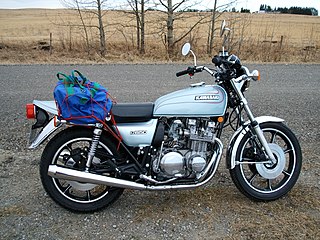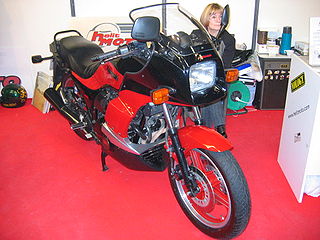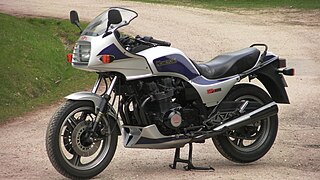
The Kawasaki Ninja ZX-7R was a motorcycle in the Ninja sport bike series from the Japanese manufacturer Kawasaki produced from 1989 until 2003. It remained largely unchanged through its production. Kawasaki used inverted forks starting in 1991, added ram air using a single tube, and in 1996, twin tube ram air and Tokico six piston brakes and fully adjustable suspension. From 1989 through 1995 in the US market, Kawasaki called the ZXR-750 and ZXR-750R the ZX-7 and ZX-7R respectively. Starting from 1996 Kawasaki dropped the ZXR name worldwide and the former ZXR-750 was now ZX-7R and the limited edition homologation special ZXR-750R/ZX-7R started in 1991 was now ZX-7RR.
The Honda XR series is a range of four-stroke off-road motorcycles that were designed in Japan but assembled all over the world.

The Kawasaki Ninja 250R is a motorcycle in the Ninja sport bike series from the Japanese manufacturer Kawasaki originally introduced in 1986. As the marque's entry-level sport bike, the motorcycle has undergone few changes throughout its quarter-century lifetime, having received only three substantial redesigns. In some markets the Ninja 250R has been succeeded by the Ninja 300.

The Kawasaki GPZ900R is a motorcycle that was manufactured by Kawasaki from 1984 to 2003. It is the earliest member of the Ninja family of sport bikes. The 1984 GPZ900R was a revolutionary design that became the immediate predecessor of the modern-day sport bike. Developed in secret over six years, it was Kawasaki's and the world's first 16-valve liquid-cooled inline four-cylinder motorcycle engine.

The Kawasaki Z500/Z550 series began with the 1979 Z500, a scaled-down version of the Kawasaki Z1R. It used a double-cradle steel frame with a transverse-mounted air-cooled 4-cylinder DOHC engine—a classic Universal Japanese Motorcycle.

The Kawasaki Z650 was produced as a 652 cc (39.8 cu in) standard motorcycle by Kawasaki from 1976 until 1983. It had a four-cylinder four-stroke, DOHC, air-cooled, wet sump engine positioned across the frame with two valves per cylinder and a five-speed gearbox. Designed as a middleweight version of the Kawasaki Z900, the similar-styling had "an attenuated version of the traditional Kawasaki tail fairing". It competed in the market against the smaller SOHC Honda CB650. The Z650 was the epitome of the "Universal Japanese Motorcycle" (UJM).

The Kawasaki Ninja 500R is a sport bike with a 498 cc (30.4 cu in) parallel-twin engine, part of the Ninja series of motorcycles manufactured by Kawasaki from 1987 to 2009, with a partial redesign in 1994. Although the motorcycle has a sporty appearance, it offers a more standard, upright riding position with greater comfort and versatility. It provides a combination of performance and low operating costs, which has made it a favorite as a first motorcycle with new riders and popular with experienced riders on a budget. 2009 was the last model year for the Ninja 500.
The Kawasaki KZ750 L3 a sport bike motorcycle made by Kawasaki starting in 1983. It was very similar to the 1982 Gpz750. This is the year during which the Gpzs made the jump towards "sportbikes", while the KZ line branched off as "sport cruisers". This model can be distinguished by the three horizontal stripes along the gas tank and tailpiece, orange, red and yellow, and the lack of fairing typical on GPZ bikes of the same era. The Kawasaki inline-four engines are considered very robust and reliable. Therefore, this motorcycle, and others with similar engines.

The ZZR1400 or Kawasaki Ninja ZX-14 and ZX-14R (2006–2022), is a motorcycle in the Ninja sport bike series from the Japanese manufacturer Kawasaki that was their most powerful sport bike as of 2006. It was introduced at the 2005 Tokyo Motor Show and released for the 2006 model year as a replacement for the Kawasaki ZZ-R1200 (2002-2005). The ZZR1400 is capable of accelerating from 0–60 mph in 2.5 seconds. The top speed is electronically limited to 186 mph (299 km/h) as a result of an agreement between the major Japanese and European motorcycle manufacturers.

The ZZ-R1100 or ZX-11 is a sport bike in Kawasaki's Ninja series made from 1990 to 2001, as the successor to the 1988–1990 Tomcat ZX-10. With a top speed of 272–283 km/h (169–176 mph), it was the fastest production motorcycle from its introduction until 1996, surpassed by the 270–290 km/h (170–180 mph) Honda CBR1100XX. It was marketed as the ZX-11 Ninja in North America and the ZZ-R1100 in the rest of the world. The C-model ran from 1990 to 1993 while the D-model ran from 1993 to 2001, when it was replaced by the ZZ-R1200 (ZX-12C) 2002-2005

The Kawasaki GPz750 Turbo was a sportbike manufactured from late 1983 to 1985, with two model years – the 1984 E1 and the 1985 E2. Differences were minor, a twin "push/pull" throttle cable for the E2 and different brake caliper stickers. The bike was manufactured in Japan, with parts also shipped to the US and assembled in Kawasaki's Nebraska plant for the US/Canada market to bypass the import tax levied on bikes over 700cc at the time by the US government, a protectionist move designed to save Harley-Davidson which was having financial problems at the time.

The Kawasaki GPz750 was a sport bike introduced by Kawasaki in 1982. In comparison with the KZ750, it had many updates focusing on high performance. Changes started at the front, with tapered bearings in the steering head instead of the KZ750's ball bearings, and the upper triple clamp was changed also, giving the GPz solid aluminum clip-on handle grips instead of the traditional handlebar. A bikini fairing almost identical to the one on the GPz550 was added too. The GPz750 had increased power, with slightly higher compression, and camshafts designed to get the valves to full lift quicker, and fitting Mikuni 34mm carburetors for smoother airflow. The cylinder heads were also given a new combustion chamber, and porting and polishing from the factory. An oil-cooler was also added. The GPz750 was the quickest factory 750, as Cycle World recorded a time of 11.93 seconds at 109.62 mph (176.42 km/h) in the 1/4 mile. The GPz750 underwent some significant changes in 1983. The original was based on the 1981 KZ750-E. Kawasaki retired the KZ750 after 1983. The 1983 KZ750L3 was nearly identical to the '82 GPz750, but for different colors, no bikini fairing, and without the porting & polishing in the cylinder head.

The Kawasaki 1400GTR, also known as the Concours 14 or ZG1400 in some markets, is a sport touring motorcycle produced by Kawasaki. The 1400GTR was introduced in September 2007 and is based on the ZX-14 platform. It replaces the original GTR1000 (Concours), which was built from 1986 to 2006.

The BSA A7 was a 500cc motorcycle model range made by Birmingham Small Arms Company (BSA) at its factory in Armoury Road, Small Heath, Birmingham. The range was launched in 1946 using a 495 cc (30.2 cu in) long stroke engine. An improved 497 cc (30.3 cu in) version based on the BSA A10 engine was launched in 1950. The various A7 models continued in production with minor modifications until 1961/2 when they were superseded by the unit-construction A50 model.

The Kawasaki GPZ1000RX was a motorcycle made by Kawasaki from 1986 to 1988. It had a 997 cc (60.8 cu in) four-cylinder, 16-valve, twin cam engine.

The Kawasaki GPZ1100 is a motorcycle that was manufactured by Kawasaki from 1981 to 1985. All four models featured fuel injection and 1,089 cc engines. All were short lived and were an attempt to fill a market segment that was rapidly changing.
Kawasaki GPZ or GPz refers to a series of motorcycles produced by Kawasaki Heavy Industries Motorcycle & Engine.
The Kawasaki GPZ1100ABS motorcycle, also labeled GPZ 1100 Horizont, was introduced in 1995. It was a sport touring motorcycle with more focus on touring than sports. Based on a ZZR-1100 motor without the ram air and detuned for more mid-range performance, it also had smaller carburetors and a more restrictive exhaust. The bike was more focused on being economical with budget brakes and suspension. Instead of the Ninjas ZX-11's alloy frame, the bike had a steel double cradle frame with a removable front member for engine removal. The motorcycle had a more relaxed seating position and leg position than the ZX-11D/ZZR-1100 or the air-cooled GPZ1100 of the early 1980s .The official Kawasaki designation was ZX1100E. It also was offered in 1996 as an ABS model.














